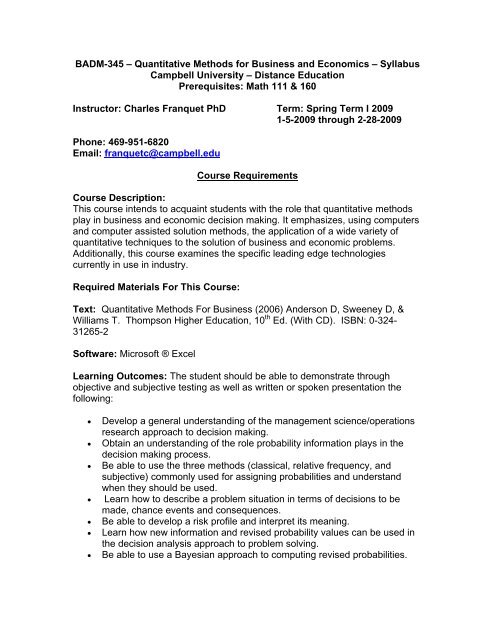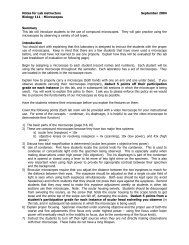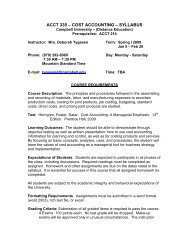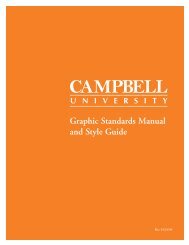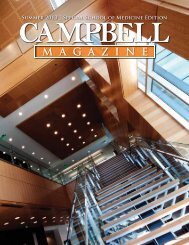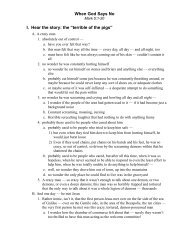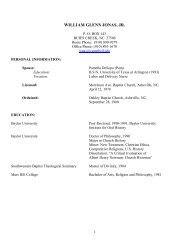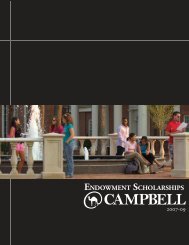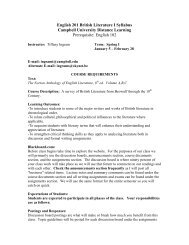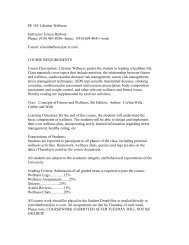BADM-345 â Quantitative Methods for Business and Economics ...
BADM-345 â Quantitative Methods for Business and Economics ...
BADM-345 â Quantitative Methods for Business and Economics ...
Create successful ePaper yourself
Turn your PDF publications into a flip-book with our unique Google optimized e-Paper software.
<strong>BADM</strong>-<strong>345</strong> – <strong>Quantitative</strong> <strong>Methods</strong> <strong>for</strong> <strong>Business</strong> <strong>and</strong> <strong>Economics</strong> – SyllabusCampbell University – Distance EducationPrerequisites: Math 111 & 160Instructor: Charles Franquet PhD Term: Spring Term I 20091-5-2009 through 2-28-2009Phone: 469-951-6820Email: franquetc@campbell.eduCourse RequirementsCourse Description:This course intends to acquaint students with the role that quantitative methodsplay in business <strong>and</strong> economic decision making. It emphasizes, using computers<strong>and</strong> computer assisted solution methods, the application of a wide variety ofquantitative techniques to the solution of business <strong>and</strong> economic problems.Additionally, this course examines the specific leading edge technologiescurrently in use in industry.Required Materials For This Course:Text: <strong>Quantitative</strong> <strong>Methods</strong> For <strong>Business</strong> (2006) Anderson D, Sweeney D, &Williams T. Thompson Higher Education, 10 th Ed. (With CD). ISBN: 0-324-31265-2Software: Microsoft ® ExcelLearning Outcomes: The student should be able to demonstrate throughobjective <strong>and</strong> subjective testing as well as written or spoken presentation thefollowing:• Develop a general underst<strong>and</strong>ing of the management science/operationsresearch approach to decision making.• Obtain an underst<strong>and</strong>ing of the role probability in<strong>for</strong>mation plays in thedecision making process.• Be able to use the three methods (classical, relative frequency, <strong>and</strong>subjective) commonly used <strong>for</strong> assigning probabilities <strong>and</strong> underst<strong>and</strong>when they should be used.• Learn how to describe a problem situation in terms of decisions to bemade, chance events <strong>and</strong> consequences.• Be able to develop a risk profile <strong>and</strong> interpret its meaning.• Learn how new in<strong>for</strong>mation <strong>and</strong> revised probability values can be used inthe decision analysis approach to problem solving.• Be able to use a Bayesian approach to computing revised probabilities.
• Underst<strong>and</strong> why utility is a better criterion than monetary value in somedecision making situations.• Underst<strong>and</strong> that the long-run success of an organization is often closelyrelated to how well management is able to predict future aspects of theoperation.• Know how regression models can be used in <strong>for</strong>ecasting.• Become familiar with the types of problems that can be solved by applyinga transportation model.• Know how to h<strong>and</strong>le the cases of (1) unequal supply <strong>and</strong> dem<strong>and</strong>, (2)unacceptable routes, <strong>and</strong> (3) maximization objective <strong>for</strong> a transportationproblem.• Underst<strong>and</strong> the role <strong>and</strong> application of PERT/CPM <strong>for</strong> project scheduling.• Learn how to define a project in terms of activities such that a network canbe used to describe the project.• Underst<strong>and</strong> what simulation is <strong>and</strong> how it aids in the analysis of aproblem.• Underst<strong>and</strong> the concept of multicriteria decision making <strong>and</strong> how it differsfrom situations <strong>and</strong> procedures involving a single criterion.• Know how to apply the analytic hierarchy process (AHP) to solve aproblem involving multiple criteria.Expectations of Students: Students are expected to complete readingassignments on the specified due dates. Discussion Board postings, exams, <strong>and</strong>projects are expected to be submitted to the instructor on the dates due.All students are subject to the academic integrity <strong>and</strong> behavioral expectations ofthe University.Grading Criteria: Submission of all graded items is required to pass this course.Four Tests (Section 1, 2, 3, & 4)-------------------------------------------600 pointsIndividual Case Research Exercise (one)-------------------------------200 pointsTeam Discussion Board (3 postings per week)----------------------100 pointsCriterion Assignment----------------------------------------------------------100 pointsA. Four tests will be given consisting of 1-3 case questions each. Eachexam accounts <strong>for</strong> 150 points or 15% of the student’s final grade.B. Individual Case Research Exercise: Each student is required tocomplete an individual case research exercise. The research exerciseis a comprehensive industry based case study with a set ofproblems/decisions <strong>for</strong> which the student must develop a solution.This accounts <strong>for</strong> 20% of the student’s overall grade.C. Team Discussion Board: The class will be sectioned into teams at thebeginning of the term. A question will be posted at the beginning ofeach week that the “Team” must answer. This accounts <strong>for</strong> 100 points/ 10% of the student’s final grade.
D. Criterion Assignment: One criterion assignment of writing skills to aselected topic will be completed by each student. Separateinstructions will be provided in the Blackboard course site to completethis requirement. This accounts <strong>for</strong> 100 points / 10% of the student’sfinal grade.Specific details <strong>for</strong> graded items listed above are located in the “How ThisCourse Works” document located under the Course In<strong>for</strong>mation tab on theBlackboard course site.The graded items may upon consultation with <strong>and</strong> approval of the instructor beturned in past the specified due dates with a st<strong>and</strong>ard 15% penalty.Web Seminars/Recorded Video Lectures: This course uses web basedseminars / lectures also known as webinars. These webinars bring the virtualclassroom to the student. There will be approximately four web seminars duringthe course. Each webinar will cover the tested subject tasks <strong>and</strong> advancestudent underst<strong>and</strong>ing. Additionally, the webinars will be supplemented withteleconferencing <strong>and</strong> audio casts. Participation is voluntary however studentsare strongly encouraged to participate. The web seminars will be recorded sothat students can “attend” or playback at will. Details <strong>for</strong> login procedures areincluded in the “How This Course Works” document located in the Blackboardcourse site.Campus RequirementsCampbell University’s Statement of Purpose: Campbell University is auniversity of the liberal arts, sciences, <strong>and</strong> professions which is committed tohelping students develop an integrated Christian personality characterized by awholeness that includes: a method of critical judgment; an appreciation of ourintellectual, cultural, <strong>and</strong> religious heritage; <strong>and</strong> a sensitive awareness of theworld <strong>and</strong> society in which they live <strong>and</strong> work with persons.Campbell University is a Baptist university affiliated with the Baptist StateConvention of North Carolina. Both in <strong>and</strong> out of the classroom, the Universityendeavors to present Christian principles to students <strong>and</strong> to foster theirapplication to daily life.This course is consistent with the a<strong>for</strong>ementioned purpose <strong>and</strong> providesstudents a positive environment <strong>for</strong> learning.ADA Statement: Students with documented disabilities who desire modificationsor accommodations should contact the Office of Student Support Serviceslocated in the University’s Hight House.Attendance: Campbell’s attendance policy states that regular attendance ism<strong>and</strong>atory. Students may miss only 15% of classes. Any student missing morethan 15% of classes may fail the course due to a lack of attendance. Distance
Education students will be required to fulfill the weekly assignment <strong>and</strong>participation requirements set <strong>for</strong>th in their instructor’s syllabus.Grading Policy: Official grades are issued <strong>for</strong> each student at the end of eachterm. Students will be graded by the letter grade system shown below.A – 90 –100 ExcellentB – 80 – 89 GoodC – 70 – 79 AverageD – 60 – 69 Below AverageF – Below 60 UnsatisfactoryInclement Weather: Campbell University’s policy is to remain in operation duringperiods of inclement weather. Distance Education courses will go as scheduled.Scheduled outages in regard to the Blackboard server will be promulagated assoon as possible.Incomplete Work: A grade of Incomplete (I) will be submitted after aconsultation with the Instructor / Student when a significant portion of therequired work is not completed.Internet/Email Requirements: This course may be web-supported or may utilizeemail <strong>for</strong> some assignments. Students are required to have <strong>and</strong> regularlymonitor their Campbell University email account. This will be the email by whichthe student will be contacted.Missed Classes: Students who are aware that they will miss a class shouldin<strong>for</strong>m the instructor be<strong>for</strong>e class. Scheduled class assignments (tests, quizzes,etc.) may be re-scheduled or made-up with a prearranged, excused absence.Plagiarism: Plagiarism is any use of another person’s words or ideas withoutgiving proper credit to the person from whom you borrowed the words or ideas.Plagiarism is the theft of intellectual property. Plagiarism includes the following:- Failing to cite properly any direct or indirect quotation(s) fromprofessionally written materials (books, journal articles, etc.) studentpapers, projects, presentations, etc.- Submitting as your own work a paper, project, or presentation that you didnot compose (that is, write, compile, draw, etc.)- Allowing another person to write your paper or develop your presentationor assignment.Students who plagiarize will be subject to failing the assignment <strong>and</strong>/or failing thecourse. Additional sanctions may be imposed by the Campus Director. See theExtended Campus Student H<strong>and</strong>book <strong>for</strong> further in<strong>for</strong>mation.Turnitin.com: “Turnitin.com” is a web-based service that provides online reviewsof written material to judge if it has been copied from another source.Turnitin.com is used to evaluate the possibility of a student plagiarizing or
cheating on written material. The instructor may require students to submitwritten work in an electronic <strong>for</strong>mat <strong>for</strong> the purpose of utilizing the Turnitin.comservice.Class Schedule of required readings, class preparation, assignments,lectures, case analysis, projects, <strong>and</strong> exams:Week 1. Read chapters 1 & 2. Introduction to the course, complete readingWeek 2. Read chapters 3 & 4. Test 1, And discussion board activities.Week 3. Read chapters 5 & 6. And discussion board activitiesWeek 4. Read chapters 7 & 8. Test 2. And discussion board activities.Week 5. Read chapters 9 & 10. And discussion board activities.Week 6. Read chapters 11 & 12. Test 3. And discussion board activities.Week 7. Individual Case Research Exercise Due. Read chapter 13 & 14.And discussion board activities.Week 8. Read chapter 15 & 16. Test 4. And discussion board activitiesWeek 9.Special topics in decision science <strong>and</strong> Six Sigma.Specific Dates <strong>for</strong> beginning <strong>and</strong> endings of weeks as well as due dates <strong>for</strong>exams, <strong>and</strong> projects are located on the Course Calendar onthe Blackboard Course site.Reading assignments are a combination of online sources as well as therequired text identified in this syllabus <strong>and</strong> will be detailed inthe Blackboard announcements at the beginning of thecourse.Note: The instructor reserves the right to change or modify this syllabuswithout prior notification in order to meet the needs of theclass.


